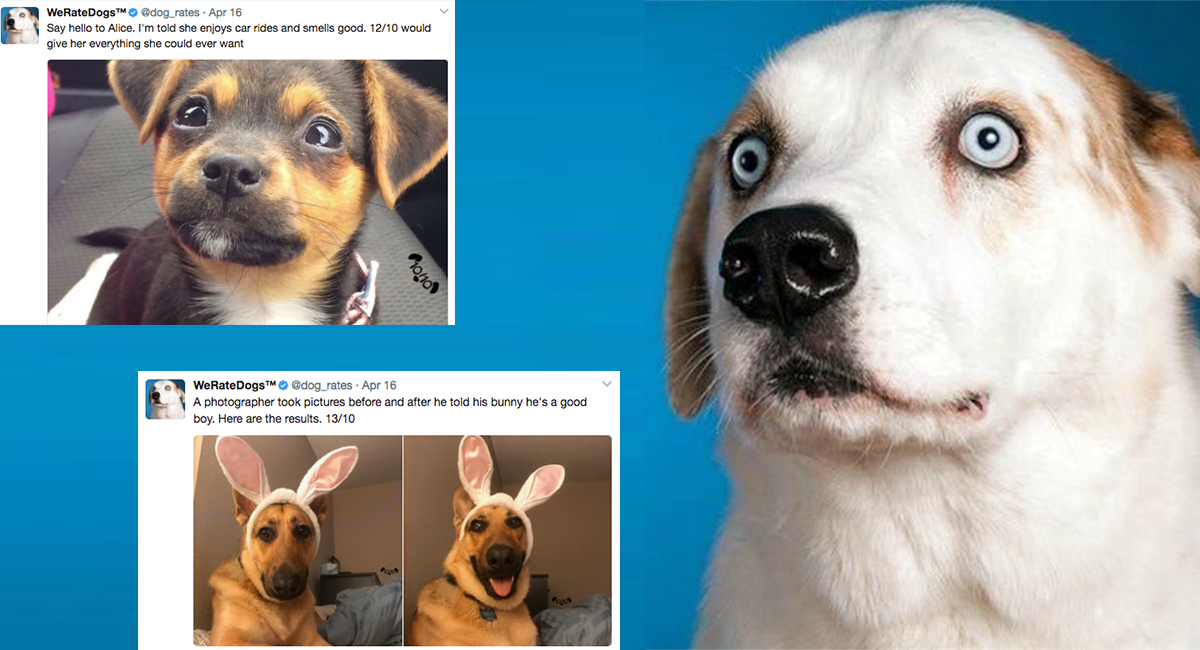Real-world data rarely comes clean. Using Python and its libraries, you will gather data from a variety of sources and in a variety of formats, assess its quality and tidiness, then clean it. This is called data wrangling. You will document your wrangling efforts in a Jupyter Notebook, plus showcase them through analyses and visualizations using Python (and its libraries) and/or SQL.
The dataset that you will be wrangling (and analyzing and visualizing) is the tweet archive of Twitter user @dog_rates, also known as WeRateDogs. WeRateDogs is a Twitter account that rates people's dogs with a humorous comment about the dog. These ratings almost always have a denominator of 10. The numerators, though? Almost always greater than 10. 11/10, 12/10, 13/10, etc. Why? Because "they're good dogs Brent." WeRateDogs has over 4 million followers and has received international media coverage.
WeRateDogs downloaded their Twitter archive and shared it exclusively for use in this project. This archive contains basic tweet data (tweet ID, timestamp, text, etc.) for all 5000+ of their tweets as they stood on August 1, 2017.
Your tasks in this project are as follows:
-
Data wrangling, which consists of:
- Gathering data
- Assessing data
- Cleaning data
-
Storing, analyzing, and visualizing your wrangled data
-
Reporting on 1) your data wrangling efforts and 2) your data analyses and visualizations
Gather each of the three pieces of data as described below in a Jupyter Notebook titled wrangle_act.ipynb:
- The WeRateDogs Twitter archive
twitter_archive_enhanced.csv. It's instructed that this file be downloaded manually from an URL provided by Udacity. - The tweet image predictions, i.e., what breed of dog (or other object, animal, etc.) is present in each tweet according to a neural network. This file (
image_predictions.tsv) hosted on Udacity's servers and should be downloaded programmatically using the Requests library and the following URL: https://d17h27t6h515a5.cloudfront.net/topher/2017/August/599fd2ad_image-predictions/image-predictions.tsv - Each tweet's retweet count and favorite (i.e. "like") count at minimum, and any additional data you find interesting. Using the tweet IDs in the WeRateDogs Twitter archive, query the Twitter API for each tweet's JSON data using Python's Tweepy library and store each tweet's entire set of JSON data in a file called
tweet_json.txtfile. Each tweet's JSON data should be written to its own line. Then read this .txt file line by line into a pandas DataFrame with (at minimum) tweet ID, retweet count, and favorite count.
After gathering each of the above pieces of data, assess them visually and programmatically for quality and tidiness issues. Detect and document at least eight (8) quality issues and two (2) tidiness issues in your wrangle_act.ipynb Jupyter Notebook. To meet specifications, the issues that satisfy the below mentioned Key Points must be assessed.
Key points to keep in mind when data wrangling for this project:
- You only want original ratings (no retweets) that have images. Though there are 5000+ tweets in the dataset, not all are dog ratings and some are retweets.
- Fully assessing and cleaning the entire dataset requires exceptional effort so only a subset of its issues (eight (8) quality issues and two (2) tidiness issues at minimum) need to be assessed and cleaned.
- Cleaning includes merging individual pieces of data according to the rules of tidy data.
- The fact that the rating numerators are greater than the denominators does not need to be cleaned. This unique rating system is a big part of the popularity of WeRateDogs.
- You do not need to gather the tweets beyond August 1st, 2017. You can, but note that you won't be able to gather the image predictions for these tweets since you don't have access to the algorithm used.
Clean each of the issues you documented while assessing. Perform this cleaning in wrangle_act.ipynb as well. The result should be a high quality and tidy master pandas DataFrame (or DataFrames, if appropriate).
Store the clean DataFrame(s) in a CSV file with the main one named twitter_archive_master.csv. If additional files exist because multiple tables are required for tidiness, name these files appropriately. Additionally, you may store the cleaned data in a SQLite database (which is to be submitted as well if you do).
Analyze and visualize your wrangled data in your wrangle_act.ipynb Jupyter Notebook. At least three (3) insights and one (1) visualization must be produced.
Create a 300-600 word written report called wrangle_report.pdf that briefly describes your wrangling efforts. This is to be framed as an internal document.
Create a >250 word written report called act_report.pdf that communicates the insights and displays the visualization(s) produced from your wrangled data. This is to be framed as an external document, like a blog post or magazine article, for example.
